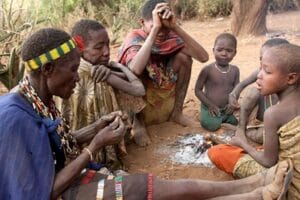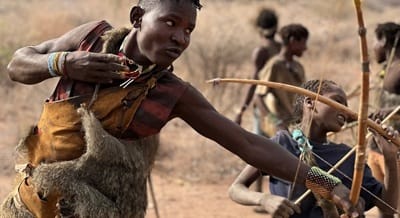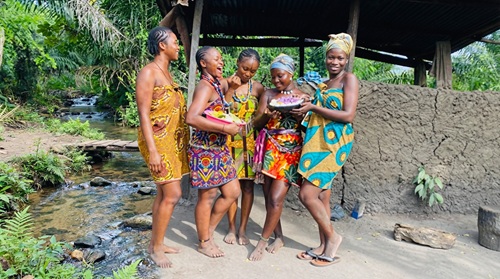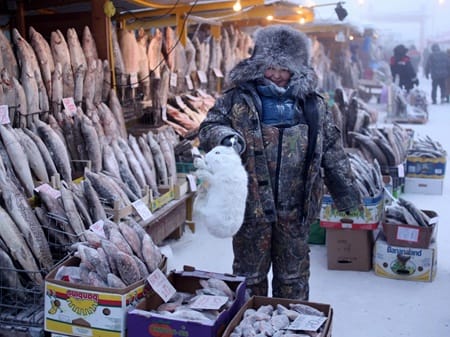In the sun-scorched savannas of northern Tanzania, tucked between the rocky hills and acacia-studded plains near Lake Eyasi, lives one of the last truly free peoples on Earth—the Hadza, also known as the Hadzabe. They are among the final remnants of a way of life that predates agriculture, industry, and even writing. Theirs is not merely a life lived close to nature—it is a life woven into the very fabric of it. No fences, no farms, no clocks. The Hadza are not relics of a bygone era; they are survivors of it.
For millennia, they have subsisted as hunter-gatherers, relying on their bowstrings, their keen senses, and the ancient knowledge passed down from generation to generation—not in books or carvings, but in footsteps, fires, and whispered stories around the hearth. While the world rushed headlong into machines and metal, the Hadza remained—resilient, untamed, uncolonized by modernity.
Let’s begin our journey where theirs has always been rooted: the land.
A Homeland Unchanged for Thousands of Years
The Hadza territory is modest in the modern sense—roughly 1,000 square miles surrounding the shimmering salt waters of Lake Eyasi in northern Tanzania. Yet this land, vast by foot and sacred by heart, has held their presence for over 40,000 years. Archaeological records, oral histories, and linguistic data all point to an unbroken human presence here since the dawn of our species. In a sense, this is where the human story began—and the Hadza are its living memory.
They move in small bands, averaging around 18 adults and their children, setting up temporary camps beneath rock overhangs or under the shade of baobab trees. Every couple of weeks, or whenever the wind changes and the herds scatter, they strike camp and move. No walls bind them. No clocks command them. Their movement flows with the rhythm of the seasons, the migration of game, and the pulse of the wild itself.
The Hadza were first officially documented in 1897 during Germany’s colonial grip on East Africa. German anthropologist Otto Dempwolff and geographer Erich Obst were among the earliest outsiders to study them. Obst, in particular, embedded himself within the Hadza community, living on their land for several weeks and recording vivid accounts of their customs, language, and survival techniques. What he described was a culture untouched by the industrial world, existing in perfect balance with the environment around them.
A Language Like No Other
The Hadza language is a linguistic marvel, spoken by fewer than 2,000 people today. It is notable for its use of click consonants, a feature it shares with a handful of other African languages, though it is not linguistically related to them. These clicks, complex and rhythmic, seem to echo the very sounds of the wild: the rustle of leaves, the crack of twigs underfoot, the chirping of insects at dusk.
Hadza children learn this language not in classrooms, but in camps—by listening, mimicking, and engaging. As globalization encroaches, some Hadza have picked up Swahili, the lingua franca of Tanzania, especially when trading or navigating interactions with the government. Yet at home, under the stars, their native tongue prevails—a melodic code that continues to connect them to each other and to the spirits of their ancestors.
Identity in Many Names
Depending on the region of Tanzania, the Hadza go by many names: Hadzabi, Hadzane, Hadzape, Hadzapi, Hatsa, or Watindiga. In Mtwara, they’re known as Wazabi. In Kilimanjaro, Watindiga. Regardless of the label, their identity is defined not by political boundaries or tribal affiliations but by their way of life.
Among Tanzania’s roughly 130 ethnic groups, the Hadza are among the smallest, with their population estimated between 1,300 and 1,500. Though they form a fraction of the nation’s 61.7 million citizens, they hold an outsized significance: a living, breathing echo of a past that the rest of humanity has all but forgotten.
The Rhythm of Daily Life
Hadza life is simple in structure yet profound in its execution. They do not raise livestock or till soil. They do not hoard food or stockpile possessions. Each day begins with the sun and ends with the firelight. Men and women contribute differently but equally.
The men—lean, wiry, and swift—hunt animals ranging from guinea fowl to dik-dik to baboons, using handcrafted bows strung with animal sinew. Their arrows are tipped with poison derived from the desert rose plant, strong enough to fell an antelope. Some men also climb precariously high trees, enduring bee stings, to harvest wild honey—a prized delicacy that provides vital calories and sweetness.
Women, graceful and strong in their own right, are the gatherers. Armed with digging sticks, they extract tubers, roots, and bulbs from the earth. They pick wild berries, gather baobab fruits, and search for edible greens. They also collect firewood, tend to the children, and construct shelters—dome-shaped huts built from branches and grass that can be assembled in just hours.
These huts are not meant to last; they’re just temporary waypoints in a life that never stays still. Whether they sleep in huts, caves, or beneath the open sky, Hadza families wrap themselves in thin cloths and rely on fire to ward off the cold. Creating that fire is a ritual as old as time—spinning a wooden stick between their palms until sparks fly from the friction into a pile of dry tinder.
Resistance to Resettlement
Time and again, external forces have tried to “settle” the Hadza. Colonial governments, missionaries, and Tanzanian officials have all attempted to draw them into permanent housing, to teach them to farm, to coerce them into the grid. But the Hadza, fiercely independent, have always walked away.
In 1964, a major resettlement push saw the Tanzanian government offer brick houses, piped water, schools, and clinics. For a time, many Hadza agreed—lured by free food and shelter. But the results were disastrous. The new diet, stripped of variety and nutrients, made many sick. The sedentary lifestyle sapped their vitality. By 1979, nearly all had abandoned the project, returning to their traditional ways.
This wasn’t stubbornness. It was survival.
In the bush, they thrive. In villages, they wither.
To this day, the Hadza are among the only tribes in Africa to have never paid taxes, never bowed to a king, never been drafted into an army. They are free in a way most modern humans can no longer comprehend.

Women of the Forest
Hadza women play a central role in their community. In addition to gathering food and building shelters, they are the keepers of herbal knowledge—locating medicinal roots and preparing remedies for wounds, fevers, and stomach ailments. They also pass down oral traditions, lullabies, and songs that preserve Hadza heritage.
Though they live in a patriarchal structure, Hadza women enjoy considerable autonomy. Marriages are informal and easily dissolved. A woman can leave her husband simply by moving her belongings to another camp. There’s no bride price, no elaborate ceremonies. If a man and woman live together in the same hut and call each other partners, that’s enough. Serial monogamy is common. Polygyny, though possible, is rare.
Hadza women, like their male counterparts, bathe infrequently—not out of neglect, but necessity. Clean water is precious. Some wash their faces in the morning; some use twigs from the Salvadora persica plant—the “toothbrush tree”—to clean their teeth. Hygiene here is dictated by the natural world, not commercial products.
A Spiritual Bond with Nature
The Hadza don’t build churches or temples. They don’t follow holy books or priestly castes. Their spirituality is woven into their daily lives through animism—the belief that every rock, tree, river, and animal has a spirit. They consider themselves part of the land, not separate from it.
They do not celebrate weddings or birthdays. There are no formal funerals. But on moonless nights, the men gather in circles to dance and chant, their movements guided by the rhythm of the women’s voices. These are not performances for tourists but sacred rituals—ceremonies meant to awaken the spirits of ancestors and maintain harmony with the unseen world.
The Secret to Their Health
Much has been made of the Hadza diet. Scientists and health researchers have flocked to their camps in recent decades, drawn by the tribe’s robust gut health and low incidence of chronic diseases. The Hadza diet is naturally high in fiber, unprocessed, and incredibly diverse. Tubers, berries, baobab fruit, wild meat, and honey make up the bulk of their meals. There is no sugar, no salt, no packaged goods. Every bite they consume comes directly from the earth.
This lifestyle promotes a gut microbiome that is among the most diverse and stable on the planet. Some researchers believe the Hadza could hold answers to the modern epidemic of digestive disorders, obesity, and autoimmune diseases.
And yet, the Hadza themselves do not ponder gut flora or caloric intake. They simply eat what’s available, what’s in season, what the land gives them. And in doing so, they flourish.
A Culture Under Threat
Despite their resilience, the Hadza face increasing threats. Encroaching agriculture, illegal poaching, and commercial tourism have begun to chip away at their land. Some Hadza have been coaxed into tourist performances—shooting arrows or starting fires for visitors with cameras. Others have been displaced by land deals struck without their consent.
Still, a core group remains committed to their traditional way of life. They roam, they hunt, they gather. They speak their language. They sing to the spirits. They live not as artifacts of the past, but as stewards of a wisdom the modern world may one day need to remember.
In the End, the Last Free People
To understand the Hadza is not just to study a tribe—it is to glimpse an alternative to everything we’ve built and become. In a world driven by speed, consumption, and control, the Hadza remind us that there is another path—one of balance, of freedom, of deep connection to the land beneath our feet.
They are not primitive. They are not poor. They are not lost.
They are exactly where they’ve always been.
Still here. Still wild. Still human.






